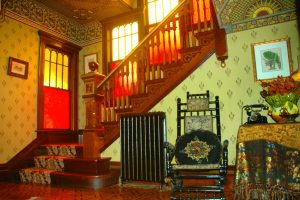After spending nearly 20 years trying to heat his 5,000-square-foot Victorian mansion, Glenn Giaimo has found a comfortable, energy-efficient solution in a combination tankless unit from Noritz.
Victorian mansions are an awesome sight to behold and could easily be considered America’s very own “castles.” Yet, when actually living in one, there can be a significant trade-off: The high-ceilinged, drafty interiors can get really cold.
That, at least, was the experience of Glenn Giaimo and his wife when they first moved into a 5,000-square-foot Victorian home in Ferndale, CA, in 1997. Built in 1901, the home’s single-paned glass windows and lack of wall insulation made for a chilly experience at times. Improving heat retention was financially unfeasible; e.g., making the thousands of window-glass pieces double-paned.
Thus, the first 15 years of the Giaimos’ residing in the home became a constant battle to heat the place effectively. Initially, a combination of pellet stoves and a forced-air furnace couldn’t provide the desired warmth. In 2000, Glenn special-ordered 34 radiators to try hydronic heating. However, frequent failures and monthly, propane- fuel bills of upwards to $1,000 during the cold season led the Giaimos to abandon this option, too.
It seemed like nothing could do the job. The Giaimos were literally relying on electric heaters and extra blankets when Glenn discovered the CB199 Combination (Combi) tankless water heater and boiler from Noritz. The dual unit was much more affordable than his other option—solar heating, which would have cost more than $20,000 to install.
 A Natural Fit
A Natural Fit
The Combi unit fits right into the Giaimos’ expensive hydronic setup from 2000, which had lain dormant for years. Glenn compared the Combi’s installation to a “miraculous heart transplant” that brought the 34 radiators back to life. The unit was installed by Fred Patterson of Patterson Sales Agency Inc., the local sales representative for Noritz, and a licensed plumber.
The new Combi boiler also fed the domestic hot water (DHW) heating system, which had previously been served by a 50-gallon storage-tank heater. Although the Giaimos had no problems with water heating, this switch was an added bonus. Removing the old tank saved space, as well as eliminated the energy-wasting need to constantly heat the stored water.
The Combi is able to convert 95 percent of the fuel it consumes into useable heat, which was crucial for the Giaimos’ situation. The home’s astounding level of heat loss was always the main reason the family had struggled to keep it warm in a cost-effective way. In addition, the home’s being on the National Historic Registry made it difficult, if not impossible, to reduce heat loss to the outdoors without altering the aesthetics of the original stained glass and clear windows.
Post-installation, and within an hour of turning on the unit, Glenn reported his first-floor set point temperature had already been reached. He also put the unit’s outdoor temperature reset control to use. Installed outdoors, the control measures the outside temperature and automatically adjusts the unit’s output to keep the interior warm. A hot-water recirculation system Glenn had installed provides nearly instantaneous hot water on the DHW side, even to the furthest fixtures.
 Super Savings
Super Savings
For the Giaimos, who had been spending $6,000 during the six cold months of the year on propane for the stainless-steel boiler and, later, roughly $350 per month to power his multiple electric heaters, the Combi unit’s efficiency made a huge impact on energy costs. Glenn reports that he now spends around $80 per month on propane, and another $80 per month on his electric bill, for an 88 percent total reduction!
Based on his experience, Glenn believes that other historic homes lacking insulation can benefit from the Combi, especially if they have hydronic heating systems already in place. Finally, 20 years after moving in, the Giaimos have found a system capable of heating their Victorian mansion.
